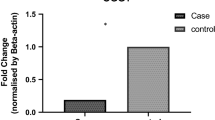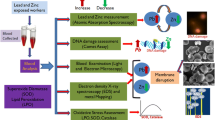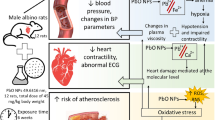Abstract
One of the most toxic heavy metals in the environment nowadays is lead (Pb). Even though exposure to lead has been reduced in some developed countries, individuals working in certain occupations are still exposed to lead at dangerous levels. Occupational exposure is of great concern and is also the main cause of lead poisoning. Although experts in various fields have been investigating the toxic effects of lead and its compounds for many years now, the association between chronic lead exposure and geno-toxicity is still an interesting point of research. The study aims to evaluate the possible DNA damage and the oxidative stress status induced by occupational exposure to lead and the role of concomitant smoking. The study was conducted on 60 subjects divided into two groups: an exposed group (40 male workers exposed to lead in their workplaces). This group was further divided into two subgroups; 20 workers were cigarette smokers and the other 20 workers were non-smokers. The other control group consists of 20 healthy males, not exposed to lead and matched by age to the exposed group (10 were smokers and the rest were non-smokers). Venous blood samples were collected from each participant for the determination of the following: blood lead level (BLL), plasma malondialdehyde (MDA) levels, and DNA damage using agarose gel electrophoresis. The exposed workers had significantly higher levels of lead and MDA, as well as a high frequency of DNA fragmentation. Smoking workers showed a greater frequency of DNA fragmentation than non-smokers. A significant relation was revealed between the BLL, as well as the MDA level, and the degree of DNA fragmentation among the lead-exposed workers. The study has shown additional evidence proving the association between Pb exposure and oxidative stress. The results further reinforced the role of cigarette smoking in augmenting such oxidative damage in the Pb-exposed population. However, further studies are recommended to evaluate the effect of cigarette smoking on Pb-exposed workers.



Similar content being viewed by others
References
Ahamed M, Siddiqui M (2007) Low level lead exposure and oxidative stress: current opinions. Clin Chim Acta 383(1):57–64
Ahmad SA, Khan MH, Khandker S, Sarwar A, Yasmin N, Faruquee M, Yasmin R (2014) Blood lead levels and health problems of lead acid battery workers in Bangladesh. Sci World J 974104
Barbosa F Jr, Tanus-Santos JE, Gerlach RF, Parsons PJ (2005) A critical review of biomarkers used for monitoring human exposure to lead: advantages, limitations, and future needs. Environ Health Perspect 113(12):1669–1674
Brocato J, Costa M (2014) Basic mechanics of DNA methylation and the unique landscape of the DNA methylome in metal-induced carcinogenesis. Crit Rev Toxicol 43:493–514
Chavez J, Cano C, Souki A, Bermudez V, Medina M, Ciszek A, Amell A, Vargas ME, Reyna N, Toledo A, Cano R, Suárez G, Contreras F, Israili ZH, Hernández-Hernández R, Valasco M (2007) Effect of cigarette smoking on the oxidant/antioxidant balance in healthy subjects. Am J Ther 4:189–193
Chinde S, Kumari M, Devi KR, Murty US, Rahman MF, Kumari SI, Mahboob M, Grover P (2014) Assessment of genotoxic effects of lead in occupationally exposed workers. Environ Sci Pollut Res 21(19):11469–11480
D’Errico M, Parlanti E, Dogliotti E (2008) Mechanism of oxidative DNA damage repair and relevance to human pathology. Mutat Res 659:4–14
Decharat S (2016) Heavy Metals Exposure and Hygienic Behaviors of Workers in Sanitary Landfill Areas in Southern Thailand. Scientifica:1–9
Denomme GA, Rios M, Reid ME (2007) Molecular protocols in transfusion medicine. Elsevier, New York, pp 1–41
Dhawan A, Mathur N, Seth PK (2001) The effect of smoking and eating habits on DNA damage in Indian population as measured in the Comet assay. Mutat Res 474(1):121–128
Dobrakowski M, Pawlas N, Kasperczyk A, Kozłowska A, Olewińska E, Machoń-Grecka A, Kasperczyk S (2017) Oxidative DNA damage and oxidative stress in lead-exposed workers. Hum Exp Toxicol 36(7):744–754
Elmore S (2007) Apoptosis: a review of programmed cell death. Toxicol Pathol 35(4):495–516
Flora S, Mittal M, Mehta A (2008) Heavy metal induced oxidative stress & its possible reversal by chelation therapy. Indian J Med Res 128(4):501–523
Flora G, Gupta D, Tiwari A (2012) Toxicity of lead: A review with recent updates. Interdiscip Toxicol 5(2):47–58
García-Lestón J, Roma-Torres J, Vilares M, Pinto R, Prista J, Teixeira JP, Mayan O, Conde J, Pingarilho M, Gaspar JF, Pásaro E, Méndez J, Laffon B (2012) Genotoxic effects of occupational exposure to lead and influence of polymorphisms in gene s involved in lead toxicokinetics and in DNA repair. Environ Int 43:29–36
Gurer H, Ercal N (2000) Can antioxidants be beneficial in the treatment of lead poisoning? Free Radic Biol Med 29:927–945
Hasani IW, Mohamed A, Sharaf NE, Shakour AA, Fahim YA, Ibrahim KA, Elhamshary M (2016) Lead and cadmium induce chromosomal aberrations and DNA damage among foundry workers. J Chem Pharm Res 8(2):652–661
Hultberg B, Andersson A, Isaksson A (2001) Interaction of metals and thiols in cell damage and glutathione distribution: potentiation of mercury toxicity by dithiothreitol. Toxicology 156:93–100
IARC Working Group on the Evaluation of Carcinogenic Risks to Humans (2006) Inorganic and organic lead compounds. IARC Monogr Eval Carcinog Risks Hum 87:1–471
Jirtle RL, Skinner MK (2007) Environmental epigenomics and disease susceptibility. Nat Rev Genet 8:253–262
Jomova K, Valko M (2011) Advances in metal-induced oxidative stress and human disease. Toxicology 283(2-3):65–87
Kasapoglu M, Ozben T (2001) Alterations of antioxidant enzymes and oxidative stress markers in aging. Exp Gerontol 36:209–220
Kasperczyk A, Słowińska-Łożyńska L, Dobrakowski M (2014) The effect of lead-induced oxidative stress on blood viscosity and rheological properties of erythrocytes in lead exposed humans. Clin Hemorheol Microcirc 56:187–195
Kim J, Lee Y, Yang M (2014) Environmental exposure to lead (Pb) and variations in its susceptibility. J Environ Sci Health Part C 32(2):159–185
Kocyigit A, Erel O, Gur S (2001) Effects of tobacco smoking on plasma selenium, zinc, copper and iron concentrations and related antioxidative enzyme activities. Clin Biochem 34(8):629–633
Koh KP, Rao A (2013) DNA methylation and methyl cytosine oxidation in cell fate decisions. Curr Opin Cell Biol 25:152–161
Li C, Yang X, Xu M, Zhang J, Sun N (2013) Epigenetic marker (LINE-1 promoter) methylation level was associated with occupational lead exposure. Clin Toxicol 51:225–229
Liu HH, Lin MH, Liu PC, Chan CI, Chen HL (2009) Health risk assessment by measuring plasma malondialdehyde (MDA), urinary 8-hydroxydeoxyguanosine (8-OH-dG) and DNA strand breakage following metal exposure in foundry workers. J Hazard Mater 170(2):699–704
Liu J, Goye R, Waalkes M (2013) Toxic effects of metals. In: Klaassen C (ed) Casarett and Doull’s Toxicology, The Basic Science of Poisons, 8th edn. McGraw-Hill, New York, pp 827–834
Mah V, Jalilehvand F (2012) Lead (II) complex formation with glutathione. Inorg Chem 51:6285–6298
Mangal D, Vudathala D, Park JH, Lee SH, Penning TM, Blair IA (2009) Analysis of 7, 8-dihydro-8-oxo-2'-deoxyguanosine in cellular DNA during oxidative stress. Chem Res Toxicol 22:788–797
Matassov D, Kagan T, Leblanc J, Sikorska M, Zakeri Z (2004) Measurement of apoptosis by DNA fragmentation. In: Brady HJ (ed) Methods in molecular biology, apoptosis methods and protocols. Humana Press Inc, New York, pp 1–17
Meng CY, Yacob AM, Esa E, Cheong KC, Yuen LK, Zakaria Z (2015) DNA Methylation of Tumor Suppressor Genes in Cytogenetically Normal versus Abnormal Acute Myeloid Leukemia. IJHSR 5(11):96–103
Mortada WI, Sobh MA, El-Defrawy MM, Farahat SE (2002) Reference intervals of cadmium, lead, and mercury in blood, urine, hair, and nails among residents in Mansoura city, Nile delta, Egypt. Environ Res 90(2):104–110
Nojima M, Sakauchi F, Mori M, Tamakoshi A, Ito Y, Watanabe Y, Inaba Y, Tajima K, Nakachi K (2009) Relationship of serum superoxide dismutase activity and lifestyle in healthy Japanese adults. Asian Pac J Cancer Prev 10(Suppl):37–40
Occupational Safety and Health Administration (OSHA) (2014) Lead Standards. OSHA, Washington, D.C
Ohkawa H, Ohishi N, Yagi K (1979) Assay for lipid peroxides in animal tissues by thiobarbituric acid reaction. Anal Biochem 95(2):351–358
Pasupathi P, Rao YY, Farook J, Saravanan G, Bakthavathsalam G (2009) Effect of cigarette smoking on lipids and oxidative stress biomarkers in patients with acute myocardial infarction. Res J Med Med Sci 4:151–159
Patel BP, Rawal UM, Shah PM, Prajapati JA, Rawal RM, Dave TK, Patel PS (2005) Study of tobacco habits and alterations in enzymatic antioxidant system in oral cancer. Oncology 68:511–519
Patrick L (2006) Lead toxicity part II: the role of free radical damage and the use of antioxidants in the pathology and treatment of lead toxicity. Altern Med Rev 11:114–127
Perkin Elmer Corporation (1982) Analytical methods for atomic absorption spectrophotometry. Perkin Elmer, Norwalk
Pinto D, Ceballos JM, Garcia G, Guzman P, Del Razo LM, Vera E, Gómez H, García A, Gonsebatt ME (2000) Increased cytogenetic damage in outdoor painters. Mutat Res 467:105–111
QIAamp DNA Mini and Blood Mini Handbook (2016). Available from: https://www.google.fr/url?sa=t&rct=j&q=&esrc=s&source=web&cd=1&ved=2ahUKEwiL4P6J4fblAhWOUBUIHR_XC7YQFjAAegQIARAC&url=https%3A%2F%2Fwww.qiagen.com%2Fch%2Fresources%2Fdownload.aspx%3Fid%3D62a200d6-faf4-469b-b50f-2b59cf738962%26lang%3Den&usg=AOvVaw2QgwEFE-am6G37FJTOD8Dk
Rajah T, Ahuja Y (1995) In vivo genotoxic effects of smoking and occupational lead exposure in printing press workers. Toxicol Lett 76(1):71–75
Rizvi SI, Maurya PK (2007) Markers of oxidative stress in erythrocytes during aging in humans. Ann N Y Acad Sci 1100:373–382
Rodrigues EG, Virji MA, McClean MD, Weinberg J, Woskie S, Pepper LD (2009) Personal exposure, behavior, and work site conditions as determinants of blood lead among bridge painters. J Occup Environ Hyg 7(2):80–87
Royce SE, Needleman HL (1992) Case Studies in Environmental Medicine. In: Lead Toxicity. Agency for Toxic Substances and Disease Registry, Atlanta
Saadat YR, Saeidi N, Vahed SZ, Barzegari A, Barar J (2015) An update to DNA ladder assay for apoptosis detection. BioImpacts 5(1):25–28
Saad-Hussein A, Hussanien MA (2001) Assessment of arsenic level in the hair of nonoccupational Egyptian Population. Environ Int 27(6):471–478
Sharma B, Singh S, Siddiqi NJ (2014) Biomedical implications of heavy metals induced imbalances in redox systems. Biomed Res Int 2014:640754
Szymański M (2014) Molecular mechanisms of lead toxicity. Bio Technologia 95(2):137–149
Tchounwou PB, Yedjou CG, Patlolla AK, Sutton DJ (2012) Heavy Metal Toxicity and the Environment. In: Luch A (ed) Molecular, Clinical and Environmental Toxicology. Springer, Basel, p 101
Tong S, von Schirnding YE, Prapamontol T (2000) Environmental lead exposure: a public health problem of global dimensions. Bull World Health Organ 78(9):1068–1077
Walez B (1979) (1979) Atomic absorption spectroscopy. Verag Chemie, Weisheim
Wyszko E, Barciszewska MZ, Markiewicz M, Szymański M, Markiewicz WT, Clark BF, Barciszewski J (2003) “Action-at-a distance” of a new DNA oxidative damage product 6-furfuryl-adenine (kinetin) on template properties of modified DNA. Biochim Biophys Acta 1625:239–245
Youssef MM, Saad A (2005) Effects of Environmental Tobacco Smoke on Blood Lead Level and Anthro-pometric Status of Egyptian Preschool Children. Cent Eur J Occup Environ Med 11(3):197–206
Author information
Authors and Affiliations
Corresponding author
Additional information
Responsible editor: Philippe Garrigues
Publisher’s note
Springer Nature remains neutral with regard to jurisdictional claims in published maps and institutional affiliations.
Rights and permissions
About this article
Cite this article
Fouad, A.A., Foda, N.T., Diab, I.H. et al. Evaluation of possible molecular toxicity induced by occupational exposure to lead and concomitant effect of smoking. Environ Sci Pollut Res 27, 411–423 (2020). https://doi.org/10.1007/s11356-019-06879-0
Received:
Accepted:
Published:
Issue Date:
DOI: https://doi.org/10.1007/s11356-019-06879-0




